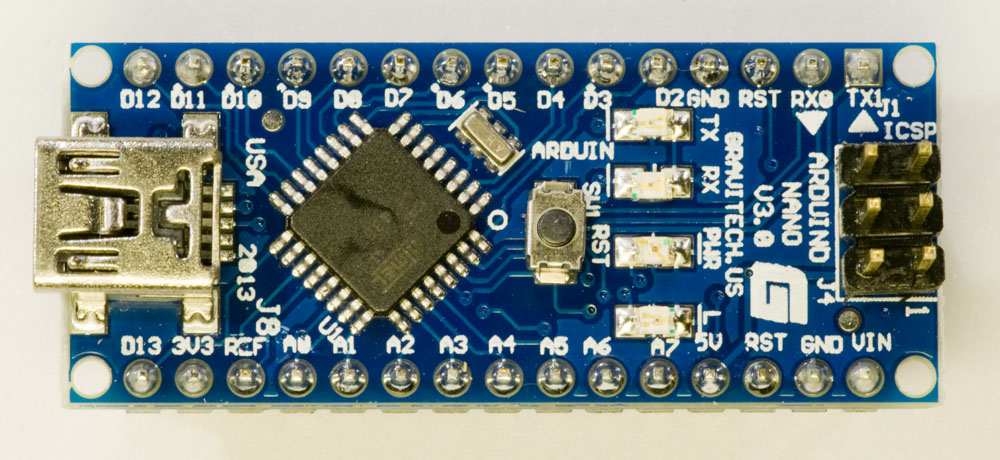

- #Arduino nano pinout v3.1 install#
- #Arduino nano pinout v3.1 driver#
- #Arduino nano pinout v3.1 Bluetooth#
- #Arduino nano pinout v3.1 download#
The Arduino Nano 33 BLE is open-source hardware! You can download the schematics for this board below:

Arduino Nano 33 BLE specifications Microcontroller
#Arduino nano pinout v3.1 Bluetooth#
It also includes other amazing features like Bluetooth pairing via NFC and ultra low power consumption modes. The main processor is a lot more powerful than the one from the standard Arduino Nano (it has 1 MB of program memory and 256 KB of RAM) and runs at a much higher clock speed. You can use the example sketches in the ArduinoLSM9DS1 library to use the sensor.

The IMU is an LSM9DS1, which is a 3-axis accelerometer, 3-axis gyroscope, and 3-axis magnetometer. The board features a u-blox NINA B306 module and also includes a 9-axis inertial measurement unit (IMU). The Arduino Nano 33 BLE is based on the powerful Nordic nRF52840 microcontroller with advanced Bluetooth capabilities. If you disconnect and reconnect your board while looking at the menu, you should be able to see which entry is the Arduino board. Next, select the right COM port under the Tools > Port menu.
#Arduino nano pinout v3.1 driver#
If you properly installed the SAMD Core, Windows should initiate its driver installation process automatically once you connect the board to your computer with a micro USB cable.īefore you can upload your program to the board, select Arduino NANO 33 IoT under Tools > Board > Arduino SAMD (32-bits ARM Cortex-M0+) Boards. Select the latest version and click Install. Now search for ‘SAMD’ and select Arduino SAMD Boards (32-bits ARM Cortex-M0+) by Arduino. To do this go to Tools > Board > Boards Manager. If you want to program this board with the Arduino desktop IDE, you need to add the Arduino SAMD Core to it. Programming the Arduino Nano 33 IoT on the Arduino IDE So, usage as analog inputs is not recommended.

As opposed to other Arduino Nano boards, pins A4 and A5 have an internal pull-up and default to be used as an I2C bus.The Arduino Nano 33 IoT is open-source hardware! You can download the schematics for this board below: SAMD21 Cortex®-M0+ 32bit low power ARM MCUġ1 (2, 3, 5, 6, 9, 10, 11, 12, 16 / A2, 17 / A3, 19 / A5)Īll digital pins (all analog pins can also be used as interrupt pins, but will have duplicated interrupt numbers) It costs even less than the original Arduino Nano! Arduino Nano 33 IoT specifications Microcontroller The Nano 33 IoT is essentially an MKR WiFi 1010, but it sacrifices a battery charger and shield compatibility in favor of a smaller footprint and lower cost. The board also features an LSM6DS3 6-axis IMU. It features an Arm Cortex-M0+ microcontroller, pre-certified ESP32-based WiFi and Bluetooth module from u-blox, and an onboard ECC608A crypto chip which provides IoT security. The Arduino Nano 33 IoT is one of the 3.3 V variants of the Arduino Nano family. In the desktop Arduino IDE, you have to select the right board type, processor, and port if you want to upload sketches to the Arduino Nano. Selecting the right board type and processor/bootloader
#Arduino nano pinout v3.1 install#
The advantage of the Arduino Web Editor is that you don’t need to install anything and your sketches are stored in the cloud. The easiest way to program the Arduino Nano is with the Arduino IDE or the Arduino Web Editor. If you connect multiple voltage sources, the power source is automatically selected to the highest voltage source. If you want to power the board in this way, you have to make sure that the voltage level is stable and does not exceed 5 V. However, this is method is not recommended because it bypasses the voltage regulators.


 0 kommentar(er)
0 kommentar(er)
